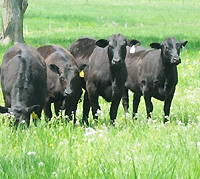With Good Management, Summer Grazing Programs Could Do Well in 2006
With Good Management, Summer Grazing Programs Could Do Well in 2006

Even in times of high calf prices, summer grazing programs in Kentucky can be profitable. A group of economists at the University of Kentucky College of Agriculture estimates that farmers who keep their own calves or buy lightweight calves to graze on grass pastures could earn $50 to $80 per head over their expenses.
“Calf prices are at historically high levels, which may scare some producers out of the summer grazing enterprise,” said Lee Meyer, Extension specialist in livestock and meat marketing. “However, farmers had the same worries during the past two years and still showed a profit.”
Kentucky is primarily a cow-calf state; most of its 45,000 cattle farms have mother cows that produce calves. A majority of cattle farmers send those calves to other states, mostly out west, for additional growth before harvest. However, each year more Kentucky farmers are putting cattle on grass pastures.
“Kentucky is a forage state, which means that perhaps its greatest resource is its pasture land,” Meyer said. “Cattle eat grass, so the best way to use this pasture resource is with cattle.”
Meyer, along with colleagues R.W. Eldridge and Kenny Burdine, analyzed a typical grazing management system: 450-pound steers grazing from April through October with no feed supplementation. The factors they considered were cattle health, rate of weight gain and market prices – the keys to cattle grazing profitability, Meyer said.
The economists then figured average daily gains at 1 ¼ pounds and a sale weight of 700 pounds. They estimated a purchase price of $130 per hundredweight ($585/head) and predicted an October sale price of $105. With a total cash cost of $720 per head, the breakeven price would be $103 per hundredweight and a net return would be about $50 per head.
“Like every year, there are both market and production risks, but producers with good management are likely to turn a profit,” Meyer said.
Because there are many different management systems that cattle farmers can use, the group also evaluated the profitability of alternative programs, including supplementing pasture with soy hulls, using heifers instead of steer calves, and buying heavier or lighter calves.
They found that supplementing pasture with soy hulls increased the net return $20 to $50 per head over the cost of the feedstuff. They also found that heifers are less profitable than steers in most cases.
While the group’s analysis demonstrated that summer grazing in Kentucky can be profitable, Meyer said he and his colleagues are careful not to influence farmers’ decisions. Rather, their goal is to provide producers with the information needed to help them make their own decisions.
“We don’t know their individual situations well enough to say, ‘This is what you should do,’” he said. “I want this information to stimulate their (producers’) own thinking and encourage them to do their own budgeting. It all comes down to the individual producer saying, ‘Should I do this given my resources and the overall market situation?’”